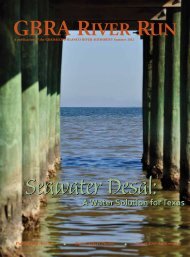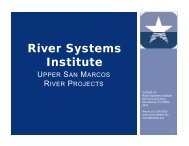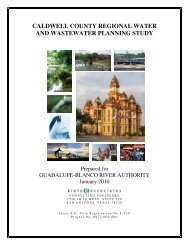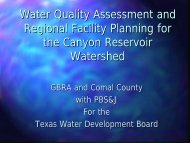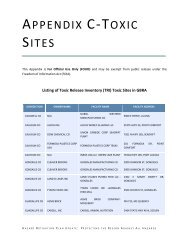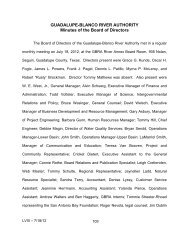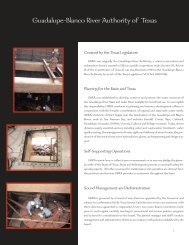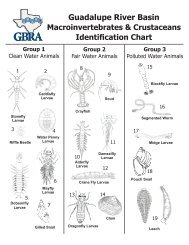Fall 2012 - Guadalupe-Blanco River Authority
Fall 2012 - Guadalupe-Blanco River Authority
Fall 2012 - Guadalupe-Blanco River Authority
You also want an ePaper? Increase the reach of your titles
YUMPU automatically turns print PDFs into web optimized ePapers that Google loves.
Photo by Charlie HickmanPhotos by Bryan SeroldWittliff emphasized the amount—about a foot and a half ofwater—because some landowners believe the barrier isresponsible for river flooding on their land. The criticism isunfounded, said Wittliff and Bryan Serold, operations manager forGBRA’s Lower Basin.“It’s important that we are talking about a foot and a half,” saidWittliff. “During flood times, the barrier is inoperative, and in timesof low flow, there is no flooding of land.” GBRA diverts a smallamount of water when the river rises, but most of the river watercontinues on a path to the bay.The <strong>Guadalupe</strong> does indeed overflow its banks during times ofheavy rainfall, inundating land that Serold called “as flat as a pooltable.” That’s nature taking its course, however. “When the river ishigh enough to flood, there are natural cuts where it flows acrossthe country,” Serold said. During flooding, the barrier bags areout of the picture. Nor does the middle support cause water tooverflow, he added, because water flows over it.The massive structure draws attention both because of itssporadic appearance and its size. Most of the barrier, whichmeasures 10 feet in diameter and 50 feet in length, is underwater.The center bulkhead provides support, with the force of the damconcentrated there. This pier is essential to successful operation."Without it, the span would be too wide for the bags to do theirjob," said Wittliff.“When we want to activate the bags, we pump water out of theriver into the bags and they swell up and create the dam. If thebarriers are up and the river floods, they deflate.”Because of boating and other river pursuits, GBRA workerstry to alert people when they inflate the barrier. “Some years youforget it’s there,” Wittliff said. “When it comes back into operation,we issue a press release.”Even during drought, the barrier helps keep the taps open forwater customers, including 15,000 people in Calhoun County. TheCity of Port Lavaca, which relied on deteriorating groundwaterbefore GBRA stepped in, would not have a secure water sourceotherwise, Wittliff said. “If we got into a drought like the 1950s, wecould not supply them water without the barrier.”GBRA <strong>River</strong> Run <strong>Fall</strong> <strong>2012</strong>13





